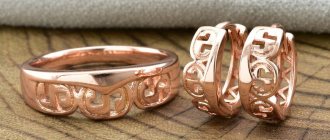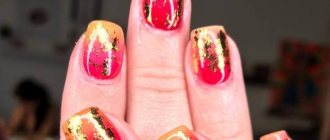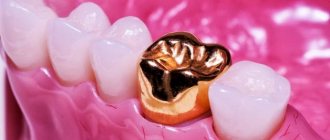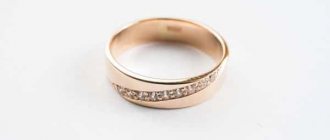Most people are familiar with white and yellow gold, but this is not a complete list of varieties of the precious metal. Among them there are rarer ones, such as a blue alloy. Jewelry made from this material is in demand despite the fact that their price is tens and sometimes hundreds of times higher than the average market price of products in this category. This is explained by the difficulties associated with manufacturing the alloy.
It is still unknown exactly how blue gold was previously obtained.
Several methods have been discovered and are used today. However, to maintain the original properties, it is necessary to ensure proper care of the products.
What is blue gold
Blue and blue gold are metals with similar properties; they are distinguished by the intensity of their shade, which is due to the difference between the compositions. Alloys can be produced in different ways, but not all of the finished materials are characterized by suitable operational parameters. In addition, even the blue color sometimes does not correspond to CIELAB color coordinates, metal is so arbitrary. In fact, the precious metal obtained using one of the technologies is characterized by a grayish tint. When the composition changes, it acquires a bluish tone. These materials belong to the group of intermetallic compounds.
They are alloys obtained by chemical reactions through the interaction of different components.
Gold ring with a blue tint
Composition, shades and hallmarks of blue and light blue gold
Today you can buy jewelry made from a rare alloy, which includes the following components: gold, steel, platinum, iridium. Their ratio is, respectively: 75%, 22%, 2.5% and 0.5%. This version of the heavenly-hued precious metal is the most common today. For comparison, the Argentinean Antoniassi previously used a method based on 90% gold, to which, among other things, a small part of cadmium was added. Nowadays, other intermetallic compounds (alloys obtained chemically based on 2 or more metals) are also used:
- standard 585 and 750, for which pure gold and iron are used in the ratio: 2:1 and 3:1, chromium and other alloys are added to the composition to improve properties;
- indium-based alloy: it allows you to obtain a precious metal of a grayish, bluish and even deep blue hue (depending on the composition), the ratio of components: 46.2% gold, 53.8% indium, as a result the standard is quite low - 462;
- based on gallium - the metal acquires a pale blue tone (component ratio: 56% gold, 44% gallium).
Why is gold different colors?
What does it depend on and what does it affect?
Jewelry is made not from gold, but from gold alloys. 999 pure gold is very soft. It will quickly become covered with scratches and even dents. Because of this, jewelers use alloys.
Gold alloys differ in their composition. Depending on the composition of the alloy, its color, flexibility, and melting point change.
Copper and silver are most often added to gold alloys. To achieve a white color, zinc and nickel are also added.
Pure 999 gold
It is very similar to the sun. If you remove the brightness, leave pure yellow and add a little metallic shine, you get the color of pure gold. As a jeweler, I can tell you that it is this color that makes a student fall in love with his future craft. What a pity that pure gold is very soft and expensive, and jewelry is not made from it.
You can get a vague idea of this color by looking at old coins from pre-revolutionary Russia. They used gold of the 958th standard, more precisely the 96th spool standard.
Gold crowns were also made from 958. Why weren’t they made from 585 or 750? Because the higher the gold standard, the softer it is. And only 958 sample was suitable for dental prosthesis. If the dental bridge were made of a harder metal, then if some hard object hit it, it would not deform itself, but would press with all its force on the gum. You wouldn't like that. Plus, gold is not subject to corrosion and generally behaves decently, being in the role of a tooth. But due to the high cost of 958, the noble metal was replaced with damask steel, a similar color, but of no value. Nowadays they do without metals altogether, using prosthetic teeth made from special ceramics.
Why does a jeweler use different types of gold?
Even at the sketch stage, the jeweler determines for himself which alloy is best to use. The choice is not only in aesthetic terms - after all, each audience likes different colors of gold and different samples, but also in practical terms, different types of alloys differ in flexibility and melting point, which is important when creating this or that jewelry.
Physical properties of chemical alloys of exotic gold
The main characteristics of the heavenly colored precious metal:
- low strength, which determines the wear resistance of products - they are easily damaged and wear out quickly (traces of use appear);
- low plasticity;
- magnetic properties depend on the steel content; not all technologies for the production of precious metals characterized by a heavenly hue require the use of such a component;
- fragility - metal cannot withstand pinpoint impacts.
Important: Not all types of jewelry are characterized by the same properties, which is due to the difference between the compositions: some deep blue products crumble and deform at the slightest pressure, others are more resistant to mechanical stress (most often those that contain iron behave this way) .
Blue gold is a rare type of material
Origin of metal tarnish colors
Metal tarnish colors spread due to the redistribution of light intensity in thin films on the reflection structure. As the film thickness develops, conditions for the extinction of rays from a certain wavelength appear. First, a lilac glow appears from the snow-white, and a yellow glow is detected. As the film grows in thickness, the wavelength of the extinguished rays increases. Green and red glows emerge from the sun's continuous spectrum.
The brightness of the tarnished shades of stainless steel depends on the size of the oxide film and the length of the solar wave that goes to the special material. Some of the brightest shades are found on copper-type materials. The tarnish colors of steel that result from the physical process depend on the metallic composition. If a microelement contains a lot of metal ions, it turns blue. In the presence of chromophores, red tints can be detected - traces of tarnish on the metal.
Artificial color discoloration is visible on the structure at elevated levels. An indispensable condition for the formation of traces of discoloration is the absence of water and other special liquids. During heating, the resulting film structure of the oxide decreases. This is explained by diffusion, that is, mixing of microelements or the introduction of one chemical element into another. In the situation with a metal oxide film, it becomes clear how oxygen atoms interact with the special metal.
Secret modern technologies for producing sky blue gold
There are several technologies for producing blue alloy. They involve connecting components and protecting finished products with a special coating. Different manufacturers use their secrets to obtain blue gold. Moreover, the exact formula is hidden. Despite the international rule established by the association of jewelers, not everyone discloses the production technology, not to mention the composition of the material.
Chemical alloys
In the production of blue precious metal jewelry, different technologies are used: alloy with iron, chemical reactions with other metals. Intermetallic compounds are compounds of gold and gallium or indium. The last of the components are fusible, they improve the properties of the material. The result is blue gold with improved characteristics than pure metal.
Such production technologies have the advantage that the product acquires the desired shade throughout its entire thickness.
Production of alloys from pure metals
Rhodium plating
In order for the decoration to obtain a noble color, a heavenly shade, different coating methods are used:
- applying special varnish;
- use of rhodium.
The presence of a coating improves the properties of the product, while the heavenly-hued precious metal retains its attractiveness longer. However, the surface layer itself is not strong and is deformed.
This means that jewelry made using this technology is less durable and has less value.
What determines the color of the metal?
The emergence of colored varieties of gold is due to the impossibility of using this metal in its pure form to create jewelry. As you know, pure gold is soft, as a result of which this material can only be used in jewelry in the form of an alloy.
It was the addition of various chemical elements to the composition in order to strengthen the metal that had a key impact not only on the physical properties of the material, but also on its color. Combining gold with additional “strengtheners,” jewelers were surprised to discover that the impurities seemed to tint the metal, and the resulting substance was no longer yellow.
This unexpected discovery gave the world many different color variations of gold and actually gave jewelry makers complete freedom of creativity - now they could create gold items of almost any shade. To simultaneously strengthen and paint in various colors, the noble metal is still combined with the following elements:
- aluminum,
- nickel,
- palladium,
- rubidium,
- chrome and others.
Today, the jewelry market offers gold products in a variety of colors. In addition to blue and cyan, unusual (that is, non-standard) shades that are in great demand include:
- white,
- green,
- red,
- violet,
- black.
The creation of blue and cyan gold is the most secret process. The technology and nuances of obtaining metal of these particular shades are carefully hidden by manufacturers and are therefore only partially known.
Narrow use of blue gold in the jewelry industry
Considering that sky-colored metal is not durable, is susceptible to pinpoint impacts, is not plastic and does not have a tendency to stretch, its scope of application is narrow. This material is used primarily for the manufacture of decorative inserts for jewelry; less often it is used in the production of solid objects. Inserts made of bluish-toned precious metal can be found in certain types of products:
- cases, bracelets of watches;
- typesetting items.
How to choose the original
Not every piece of blue jewelry contains gold. To check whether a ring or chain is a piece of jewelry, the following criteria must be taken into account:
- hallmark and manufacturer's mark: a product that contains a precious metal is always marked with a symbol that determines the value of the alloy used in production (fine), most often there is also a manufacturer's mark;
- magnetic properties: for comparison, yellow gold does not exhibit such characteristics, however, the blue alloy may contain iron, which puts the jewelry into a lower quality category, and products of this type also exhibit magnetic properties; there are also varieties of blue precious metal based on gallium and indium , they do not contain steel;
- trusted brand, well-known salon: large stores have gained popularity due to the sale of certified high-quality goods; when purchasing, you should choose well-known retail chains that have been on the market for a long time;
- an electronic detector is one of the expensive methods; such a device is not available everywhere, but thanks to the detector you can determine the electrical conductivity of the metal, which will allow you to find out its composition;
- shopping accompanied by a jeweler: you need to invite a trusted specialist, but his services are an additional expense item; as a result, the jewelry will cost more in total.
Jewelry made of gold with a blue tint with green stones
Important! You should not check jewelry using traditional methods (using vinegar, iodine, etc.), because they do not guarantee an accurate result, they can ruin the product, in addition, often improvised means give a false impression of the properties of the jewelry (when applied, the material does not lose its properties, like gold, but there is no precious metal in the composition).
FAQ
Does white gold occur in nature?
No, white gold does not occur in nature. It is made by hand by adding silver-white metals. The first versions of white gold were created in the 18th century in Germany. However, white gold, a replacement for platinum, was first produced in the 1920s.
How rare is white gold?
White gold is not that rare because it is made from gold, which is often found in free elemental (native) form as well as in minerals.
Platinum, however, is very rare. It is one of the rarest metals in the earth's crust, with an average content of about 5 micrograms per kilogram. With only a few hundred tons produced each year, platinum is one of the major precious metals.
Can regular white gold turn yellow?
Nowadays, almost every piece of white gold jewelry is plated with rhodium (a silvery-white metal), so it will not yellow or tarnish with normal wear. However, this coating must be replaced every few years. Otherwise, the rhodium gradually wears away, revealing the true tone of white gold.
Can hand sanitizer damage white gold jewelry?
Yes, anything containing alcohol can damage white gold jewelry. Because alcohol is corrosive, it can gradually eat away at the metal finish of jewelry. If the sanitizer contains excessive amounts of alcohol, it may cause white gold jewelry to lose its luster more quickly.
White gold contains cheaper alloys, which means the purity (karat) of your gold jewelry is reduced. It is for this reason that white gold has a lower resale value than 22K or 18K yellow gold. If you are buying jewelry for investment purposes, it is better to choose purer, reddish-yellow gold or silver-white platinum.
Post updated: May 25, 2020
How to care for fragile metal
Basic recommendations:
- blue gold is easily damaged, so jewelry of this type should not be worn daily;
- Products should be wiped from time to time with a rag soaked in a soapy solution;
- For storage, choose a box with a soft coating inside, but it is important to keep jewelry made of blue precious metal separately from the rest.
Gold ring with blue tint
Where can you buy and how to sell blue jewelry. Cost of 1 gram of blue gold
You can't buy heavenly shades everywhere. The likelihood of finding them in the assortment of large retail chains is much higher than in small stores. It is difficult to sell such products because their cost is high. Options to consider:
- pawnshop;
- selling to a store for the purpose of purchasing a new product.
The cost of jewelry of different composition differs significantly. If we consider blue gold, the price for 1 gram today is 10,000 rubles.
Cost of blue metal
Since the process of making this metal is still surrounded by secrets, not every master can boast of the ability to obtain it. It is only known that the process itself is labor-intensive, and therefore the price of this metal is higher than that of ordinary gold (from 10,000 rubles per 1 gram). As a rule, this is an individual order that comes from a client with high income. After all, making such jewelry for general sale is unprofitable.
Blue gold Antoniassi
This unique technique can be applied to this proposal.
After a short detour to the school playground, you will be taken to a roofing shop. This is treated in detail, and guests get the first idea of the ornamentation technique. Zeiner Gibel, the oldest dated stanniol slate pediment, is explained in detail before the craftsmanship begins. Together we explain the basics of the old skill and create a motif that we later apply on the slide. You can, of course, take your work home with you. The stationary workshop lasts from 120 to 150 minutes, including. Price for group up to max. 15 people, including all services: 180, – €. A drinks package is available upon request. Possibility of booking from Monday to Friday, Saturday on request.
The cost of jewelry depends not only on the alloy of the precious metal and the complexity of the work. The price is determined by the following factors:
- artistic design of the product;
- the presence and volume of precious stones included in the composition of the jewelry;
- level of professional skill, name of the jeweler or jewelry factory.
This tour can also be booked for English speaking guests. And when the group is a little larger? From 15 people we offer special group tours. The Schaefermuseum in Ludwigsstadt is part of the Hermann Zellner Foundation. Three floors show all the facets of blue gold. The exhibition has been designed with great attention to detail and is always updated by the Geological and Horticultural Working Group. A visit – also for individual guests – is always worth it! Slate has characterized the Thuringian-Franconian slate region for centuries, and with it the people who lived with and from the blue rock.
Reviews
My husband gave me a bracelet with blue gold inserts. To be honest, for a long time I thought it was colored blue metal (no one showed me the receipt, naturally). I recently found out that the price of this blue gold per gram of 585 samples was amazing - more than 9,000 rubles. After that, I looked at my husband differently; it turned out that, although he is silent, he appreciates me.
Nastya Grineva, Beloretsk
Angela Gusina, Krasnodar
When I worked for a foreign company, I could afford a holiday in the Maldives 4 times a year, expensive jewelry. There was even a blue gold ring. But when worn it is so-so, it gets scratched quickly. I only wore it to special occasions.
One day, an unpleasant situation happened with blue gold: an ex-boyfriend gave it as a gift and presented it with pathos. Later, when we had already separated, I decided to sell it; it turned out that it was a simple decoration coated in a blue tone. The price, of course, is different for such a product - much lower.
Veronica S., Nizhny Novgorod
The origin story of the celestial metal
Even ancient jewelers conducted various experiments on the alloy of precious metals, adding ordinary metals to them. As a result of centuries of experience, we have the widest range of gold alloys, and as a result - a variety of jewelry for every taste and color.
The test on metal is an important indicator of its quality
It is also a powerful cell poison that can effectively destroy microorganisms.
Since once the water has been disinfected it can be expelled by passing an air stream, problems with residues do not occur as described above for chlorine. The production of ozone is also very simple in principle: it is only necessary to apply a high voltage between two electrodes, which generate ozone when air is released. After a thunderstorm, notice the sweet smell in the air. Natural ozone production occurs here. The disadvantage of this process is that expensive ozone generators and a power supply are required. To preserve, silver salts can be added in low concentrations, resulting in purified water that can last up to six months. Although silver ions do not kill microorganisms, they prevent their proliferation. Due to their high affinity for sulfur, silver ions react with the sulfur-containing amino acid cysteine and thus interfere with the folding and therefore the function of proteins that are essential for the metabolism of bacteria and viruses.
Scientists have proven that blue gold was first discovered among the Scythians. As a result of excavations, stunningly beautiful jewelry made from this heavenly colored metal was found. Since this artifact was of high value, no one undertook to study the composition of the Scythian craftsmen. But there is information that ancient alchemists obtained blue gold by combining an alloy consisting of 1/3 iron and 2/3 natural gold. When testing this hypothesis, it was found that the connection was unstable and after a couple of days, corrosion appeared on the gold as a result of oxidation. There is no need to talk about it as a precious metal; the alloy is more related to gold-plated steel.
In this way, effective purification of clean water from bacteria, but not from permanent forms of parasites, can also be achieved. Please don't host a workshop! But very special! It was, so to speak, "the place to go" for all those associated with blue gold. Even today, quite impressive relics from this period demonstrate the previously high economic importance for the entire region. So what makes this offer so special? It's the silver dress that makes it go.
What is an intermetallic compound?
Silver is not entirely accurate. It is the tannin that makes it so special. Stanniol painting, decorating entire walls with drawings, images and sayings with thinly rolled tin foil, only existed in a small part of the Thuringian-Franconian Schiefergebirge.











